Explainable Artificial Intelligence to Investigate the Contribution of Design Variables to the Static Characteristics of Bistable Composite Laminates
Abstract
:1. Introduction
2. Methodology
2.1. Theoretical Model of Bistable Laminates
2.2. SHAP
2.3. XGBoost
2.4. The Characteristics of the Laminates
3. Results
3.1. Features Importance for the Curvatures
3.2. Features Importance for the Snap-Through Load
4. Conclusions
Author Contributions
Funding
Institutional Review Board Statement
Informed Consent Statement
Data Availability Statement
Conflicts of Interest
References
- Elsheikh, A. Bistable Morphing Composites for Energy-Harvesting Applications. Polymers 2022, 14, 1893. [Google Scholar] [CrossRef] [PubMed]
- Lu, Z.-Q.; Shao, D.; Fang, Z.-W.; Ding, H.; Chen, L.-Q. Integrated Vibration Isolation and Energy Harvesting via a Bistable Piezo-Composite Plate. J. Vib. Control 2020, 26, 779–789. [Google Scholar] [CrossRef]
- Li, Y.; Zhang, Z.; Yu, X.; Chai, H.; Lu, C.; Wu, H.; Wu, H.; Jiang, S. Tristable Behaviour of Cross-Shaped Unsymmetric Fibre-Reinforced Laminates with Concave–Convex Boundaries. Eng. Struct. 2020, 225, 111253. [Google Scholar] [CrossRef]
- Sun, M.; Zhou, H.; Liao, C.; Zhang, Z.; Zhang, G.; Jiang, S.; Zhang, F. Stable Characteristics Optimization of Anti-Symmetric Cylindrical Shell with Laminated Carbon Fiber Composite. Materials 2022, 15, 933. [Google Scholar] [CrossRef]
- Saberi, S.; Hosseini, A.S.; Yazdanifar, F.; Castro, S.G.P. Developing Equations for Free Vibration Parameters of Bistable Composite Plates Using Multi-Objective Genetic Programming. Polymers 2022, 14, 1559. [Google Scholar] [CrossRef]
- Wang, B.; Seffen, K.A.; Guest, S.D. Folded Strains of a Bistable Composite Tape-Spring. Int. J. Solids Struct. 2021, 233, 111221. [Google Scholar] [CrossRef]
- Zhang, Z.; Sun, M.; Li, Y. Advances in Multistable Composite Structures and Their Applications. In Composite Materials; Elsevier: Amsterdam, The Netherlands, 2021; pp. 421–463. [Google Scholar] [CrossRef]
- Zhang, Z.; Pei, K.; Sun, M.; Wu, H.; Yu, X.; Wu, H.; Jiang, S.; Zhang, F. A Novel Solar Tracking Model Integrated with Bistable Composite Structures and Bimetallic Strips. Compos. Struct. 2020, 248, 112506. [Google Scholar] [CrossRef]
- Mattioni, F.; Weaver, P.M.; Friswell, M.I. Multistable Composite Plates with Piecewise Variation of Lay-up in the Planform. Int. J. Solids Struct. 2009, 46, 151–164. [Google Scholar] [CrossRef]
- Telford, R.; Katnam, K.B.; Young, T.M. Analysing Thermally Induced Macro-Scale Residual Stresses in Tailored Morphing Composite Laminates. Compos. Struct. 2014, 117, 40–50. [Google Scholar] [CrossRef]
- Saberi, S.; Abdollahi, A.; Friswell, M.I. Probability Analysis of Bistable Composite Laminates Using the Subset Simulation Method. Compos. Struct. 2021, 271, 114120. [Google Scholar] [CrossRef]
- Dano, M.-L.; Hyer, M.W. Snap-through of Unsymmetric Fiber-Reinforced Composite Laminates. Int. J. Solids Struct. 2002, 39, 175–198. [Google Scholar] [CrossRef]
- Saberi, S.; Abdollahi, A.; Inam, F. Reliability Analysis of Bistable Composite Laminates. AIMS Mater. Sci. 2021, 8, 29–41. [Google Scholar] [CrossRef]
- Hyer, M.W. Some Observations on the Cured Shape of Thin Unsymmetric Laminates. J. Compos. Mater. 1981, 15, 175–194. [Google Scholar] [CrossRef]
- Hyer, M.W. The Room-Temperature Shapes of Four-Layer Unsymmetric Cross-Ply Laminates. J. Compos. Mater. 1982, 16, 318–340. [Google Scholar] [CrossRef]
- Dano, M.-L.; Hyer, M.W. Thermally-Induced Deformation Behavior of Unsymmetric Laminates. Int. J. Solids Struct. 1998, 35, 2101–2120. [Google Scholar] [CrossRef]
- Cho, M.; Roh, H.Y. Non-Linear Analysis of the Curved Shapes of Unsymmetric Laminates Accounting for Slippage Effects. Compos. Sci. Technol. 2003, 63, 2265–2275. [Google Scholar] [CrossRef]
- Cantera, M.A.; Romera, J.M.; Adarraga, I.; Mujika, F. Hygrothermal Effects in Composites: Influence of Geometry and Determination of Transverse Coefficient of Thermal Expansion. J. Reinf. Plast. Compos. 2012, 31, 1270–1281. [Google Scholar] [CrossRef]
- Brampton, C.J.; Betts, D.N.; Bowen, C.R.; Kim, H.A. Sensitivity of Bistable Laminates to Uncertainties in Material Properties, Geometry and Environmental Conditions. Compos. Struct. 2013, 102, 276–286. [Google Scholar] [CrossRef]
- Zhang, Z.; Ye, G.; Wu, H.; Wu, H.; Chen, D.; Chai, G. Thermal Effect and Active Control on Bistable Behaviour of Anti-Symmetric Composite Shells with Temperature-Dependent Properties. Compos. Struct. 2015, 124, 263–271. [Google Scholar] [CrossRef]
- Cantera, M.A.; Romera, J.M.; Adarraga, I.; Mujika, F. Modelling of [0/90] Laminates Subject to Thermal Effects Considering Mechanical Curvature and through-the-Thickness Strain. Compos. Struct. 2014, 110, 77–87. [Google Scholar] [CrossRef]
- Wu, Y.; Gao, K.; Ren, Q. Hydrothermal Effect on Bi-Stability of Composite Cylindrical Shell. Compos. Struct. 2020, 232, 111554. [Google Scholar] [CrossRef]
- Chillara, V.S.C.; Dapino, M.J. Bistable Laminates with Non-Cylindrical Curved Shapes. Compos. Struct. 2019, 230, 111502. [Google Scholar] [CrossRef]
- Chai, H.; Li, Y.; Zhang, Z.; Sun, M.; Wu, H.; Jiang, S. Systematic Analysis of Bistable Anti-Symmetric Composite Cylindrical Shells and Variable Stiffness Composite Structures in Hygrothermal Environment. Int. J. Adv. Manuf. Technol. 2020, 108, 1091–1107. [Google Scholar] [CrossRef]
- Zhang, Z.; Pei, K.; Wu, H.; Sun, M.; Chai, H.; Wu, H.; Jiang, S. Bistable Characteristics of Hybrid Composite Laminates Embedded with Bimetallic Strips. Compos. Sci. Technol. 2021, 212, 108880. [Google Scholar] [CrossRef]
- Mattioni, F.; Weaver, P.M.; Potter, K.D.; Friswell, M.I. Analysis of Thermally Induced Multistable Composites. Int. J. Solids Struct. 2008, 45, 657–675. [Google Scholar] [CrossRef]
- Pirrera, A.; Avitabile, D.; Weaver, P.M. On the Thermally Induced Bistability of Composite Cylindrical Shells for Morphing Structures. Int. J. Solids Struct. 2012, 49, 685–700. [Google Scholar] [CrossRef]
- Cantera, M.A.; Romera, J.M.; Adarraga, I.; Mujika, F. Modelling and Testing of the Snap-through Process of Bi-Stable Cross-Ply Composites. Compos. Struct. 2015, 120, 41–52. [Google Scholar] [CrossRef]
- Emam, S.A. Snapthrough and Free Vibration of Bistable Composite Laminates Using a Simplified Rayleigh-Ritz Model. Compos. Struct. 2018, 206, 403–414. [Google Scholar] [CrossRef]
- Zhang, W.; Liu, Y.Z.; Wu, M.Q. Theory and Experiment of Nonlinear Vibrations and Dynamic Snap-through Phenomena for Bi-Stable Asymmetric Laminated Composite Square Panels under Foundation Excitation. Compos. Struct. 2019, 225, 111140. [Google Scholar] [CrossRef]
- Pan, D.; Wu, Z.; Dai, F. An Analysis for Snap-through Behavior of Bi-Stable Hybrid Symmetric Laminate with Cantilever Boundary. Compos. Struct. 2021, 258, 113331. [Google Scholar] [CrossRef]
- Zhang, Z.; Wu, H.; Ye, G.; Yang, J.; Kitipornchai, S.; Chai, G. Experimental Study on Bistable Behaviour of Anti-Symmetric Laminated Cylindrical Shells in Thermal Environments. Compos. Struct. 2016, 144, 24–32. [Google Scholar] [CrossRef]
- Le Chau, N.; Tran, N.T.; Dao, T.-P. A Multi-Response Optimal Design of Bistable Compliant Mechanism Using Efficient Approach of Desirability, Fuzzy Logic, ANFIS and LAPO Algorithm. Appl. Soft Comput. 2020, 94, 106486. [Google Scholar] [CrossRef]
- Liu, F.; Jiang, X.; Wang, X.; Wang, L. Machine Learning-Based Design and Optimization of Curved Beams for Multistable Structures and Metamaterials. Extrem. Mech. Lett. 2020, 41, 101002. [Google Scholar] [CrossRef]
- Reddy, J.N. Mechanics of Laminated Composite Plates and Shells: Theory and Analysis; CRC Press: Boca Raton, FL, USA, 2003; ISBN 0203502809. [Google Scholar]
- Belardi, V.G.; Fanelli, P.; Vivio, F. Application of the Ritz Method for the Bending and Stress Analysis of Thin Rectilinear Orthotropic Composite Sector Plates. Thin-Walled Struct. 2023, 183, 110374. [Google Scholar] [CrossRef]
- Chen, X.; Nie, G.; Wu, Z. Application of Rayleigh-Ritz Formulation to Thermomechanical Buckling of Variable Angle Tow Composite Plates with General in-Plane Boundary Constraint. Int. J. Mech. Sci. 2020, 187, 106094. [Google Scholar] [CrossRef]
- Vaseghi, O.; Mirdamadi, H.R.; Panahandeh-Shahraki, D. Non-Linear Stability Analysis of Laminated Composite Plates on One-Sided Foundation by Hierarchical Rayleigh–Ritz and Finite Elements. Int. J. Non. Linear. Mech. 2013, 57, 65–74. [Google Scholar] [CrossRef]
- Wakjira, T.G.; Al-Hamrani, A.; Ebead, U.; Alnahhal, W. Shear Capacity Prediction of FRP-RC Beams Using Single and Ensenble ExPlainable Machine Learning Models. Compos. Struct. 2022, 287, 115381. [Google Scholar] [CrossRef]
- Bakouregui, A.S.; Mohamed, H.M.; Yahia, A.; Benmokrane, B. Explainable Extreme Gradient Boosting Tree-Based Prediction of Load-Carrying Capacity of FRP-RC Columns. Eng. Struct. 2021, 245, 112836. [Google Scholar] [CrossRef]
- Bekdaş, G.; Cakiroglu, C.; Kim, S.; Geem, Z.W. Optimal Dimensioning of Retaining Walls Using Explainable Ensemble Learning Algorithms. Materials 2022, 15, 4993. [Google Scholar] [CrossRef]
- Anjum, M.; Khan, K.; Ahmad, W.; Ahmad, A.; Amin, M.N.; Nafees, A. New SHapley Additive ExPlanations (SHAP) Approach to Evaluate the Raw Materials Interactions of Steel-Fiber-Reinforced Concrete. Materials 2022, 15, 6261. [Google Scholar] [CrossRef]
- Khan, K.; Ahmad, W.; Amin, M.N.; Ahmad, A.; Nazar, S.; Alabdullah, A.A. Compressive Strength Estimation of Steel-Fiber-Reinforced Concrete and Raw Material Interactions Using Advanced Algorithms. Polymers 2022, 14, 3065. [Google Scholar] [CrossRef] [PubMed]
- Anjum, M.; Khan, K.; Ahmad, W.; Ahmad, A.; Amin, M.N.; Nafees, A. Application of Ensemble Machine Learning Methods to Estimate the Compressive Strength of Fiber-Reinforced Nano-Silica Modified Concrete. Polymers 2022, 14, 3906. [Google Scholar] [CrossRef] [PubMed]
- Chelgani, S.C.; Nasiri, H.; Alidokht, M. Interpretable Modeling of Metallurgical Responses for an Industrial Coal Column Flotation Circuit by XGBoost and SHAP-A “Conscious-Lab” Development. Int. J. Min. Sci. Technol. 2021, 31, 1135–1144. [Google Scholar] [CrossRef]
- Mangalathu, S.; Hwang, S.-H.; Jeon, J.-S. Failure Mode and Effects Analysis of RC Members Based on Machine-Learning-Based SHapley Additive ExPlanations (SHAP) Approach. Eng. Struct. 2020, 219, 110927. [Google Scholar] [CrossRef]
- Lundberg, S.M.; Lee, S.-I. A Unified Approach to Interpreting Model Predictions. In Proceedings of the Advances in Neural Information Processing Systems 30 (NIPS 2017), Long Beach, CA, USA, 4–9 December 2017; p. 30. [Google Scholar]
- Alkadhim, H.A.; Amin, M.N.; Ahmad, W.; Khan, K.; Nazar, S.; Faraz, M.I.; Imran, M. Evaluating the Strength and Impact of Raw Ingredients of Cement Mortar Incorporating Waste Glass Powder Using Machine Learning and SHapley Additive ExPlanations (SHAP) Methods. Materials 2022, 15, 7344. [Google Scholar] [CrossRef]
- Merrick, L.; Taly, A. The Explanation Game: Explaining Machine Learning Models Using Shapley Values. In Proceedings of the International Cross-Domain Conference for Machine Learning and Knowledge Extraction, Dublin, Ireland, 25–28 August 2020; Springer: Cham, Switzerland, 2020; pp. 17–38. [Google Scholar]
- Owen, A.B. Sobol’indices and Shapley Value. SIAM/ASA J. Uncertain. Quantif. 2014, 2, 245–251. [Google Scholar] [CrossRef]
- Benoumechiara, N.; Elie-Dit-Cosaque, K. Shapley Effects for Sensitivity Analysis with Dependent Inputs: Bootstrap and Kriging-Based Algorithms. ESAIM Proc. Surv. 2019, 65, 266–293. [Google Scholar] [CrossRef]
- Iooss, B.; Prieur, C. Shapley Effects for Sensitivity Analysis with Correlated Inputs: Comparisons with Sobol’indices, Numerical Estimation and Applications. Int. J. Uncertain. Quantif. 2019, 9. [Google Scholar] [CrossRef]
- Song, E.; Nelson, B.L.; Staum, J. Shapley Effects for Global Sensitivity Analysis: Theory and Computation. SIAM/ASA J. Uncertain. Quantif. 2016, 4, 1060–1083. [Google Scholar] [CrossRef]
- Broto, B.; Bachoc, F.; Depecker, M. Variance Reduction for Estimation of Shapley Effects and Adaptation to Unknown Input Distribution. SIAM/ASA J. Uncertain. Quantif. 2020, 8, 693–716. [Google Scholar] [CrossRef]
- Owen, A.B.; Prieur, C. On Shapley Value for Measuring Importance of Dependent Inputs. SIAM/ASA J. Uncertain. Quantif. 2017, 5, 986–1002. [Google Scholar] [CrossRef]
- Fatahi, R.; Nasiri, H.; Homafar, A.; Khosravi, R.; Siavoshi, H.; Chehreh Chelgani, S. Modeling Operational Cement Rotary Kiln Variables with Explainable Artificial Intelligence Methods—A “Conscious Lab” Development. Part. Sci. Technol. 2023, 41, 715–724. [Google Scholar] [CrossRef]
- Chen, T.; Guestrin, C. Xgboost: A Scalable Tree Boosting System. In Proceedings of the 22nd ACM SIGKDD International Conference on Knowledge Discovery and Data Mining, San Francisco, CA, USA, 6–10 August 2016; pp. 785–794. [Google Scholar]
- Zou, M.; Jiang, W.-G.; Qin, Q.-H.; Liu, Y.-C.; Li, M.-L. Optimized XGBoost Model with Small Dataset for Predicting Relative Density of Ti-6Al-4V Parts Manufactured by Selective Laser Melting. Materials 2022, 15, 5298. [Google Scholar] [CrossRef]
- Mangalathu, S.; Shin, H.; Choi, E.; Jeon, J.-S. Explainable Machine Learning Models for Punching Shear Strength Estimation of Flat Slabs without Transverse Reinforcement. J. Build. Eng. 2021, 39, 102300. [Google Scholar] [CrossRef]
- Amin, M.N.; Salami, B.A.; Zahid, M.; Iqbal, M.; Khan, K.; Abu-Arab, A.M.; Alabdullah, A.A.; Jalal, F.E. Investigating the Bond Strength of FRP Laminates with Concrete Using LIGHT GBM and SHAPASH Analysis. Polymers 2022, 14, 4717. [Google Scholar] [CrossRef] [PubMed]
- Ghaheri, P.; Shateri, A.; Nasiri, H. PD-ADSV: An Automated Diagnosing System Using Voice Signals and Hard Voting Ensemble Method for Parkinson’s Disease. Softw. Impacts 2023, 16, 100504. [Google Scholar] [CrossRef]
- Zhang, C.; Hu, D.; Yang, T. Anomaly Detection and Diagnosis for Wind Turbines Using Long Short-Term Memory-Based Stacked Denoising Autoencoders and XGBoost. Reliab. Eng. Syst. Saf. 2022, 222, 108445. [Google Scholar] [CrossRef]
- Kardani, N.; Bardhan, A.; Gupta, S.; Samui, P.; Nazem, M.; Zhang, Y.; Zhou, A. Predicting Permeability of Tight Carbonates Using a Hybrid Machine Learning Approach of Modified Equilibrium Optimizer and Extreme Learning Machine. Acta Geotech. 2022, 17, 1239–1255. [Google Scholar] [CrossRef]
- Ogunleye, A.; Wang, Q.-G. XGBoost Model for Chronic Kidney Disease Diagnosis. IEEE/ACM Trans. Comput. Biol. Bioinforma. 2019, 17, 2131–2140. [Google Scholar] [CrossRef]
- Zhang, W.; Wu, C.; Zhong, H.; Li, Y.; Wang, L. Prediction of Undrained Shear Strength Using Extreme Gradient Boosting and Random Forest Based on Bayesian Optimization. Geosci. Front. 2021, 12, 469–477. [Google Scholar] [CrossRef]
- Xu, Y.; Zhao, X.; Chen, Y.; Yang, Z. Research on a Mixed Gas Classification Algorithm Based on Extreme Random Tree. Appl. Sci. 2019, 9, 1728. [Google Scholar] [CrossRef]
- Chehreh Chelgani, S.; Nasiri, H.; Tohry, A.; Heidari, H.R. Modeling Industrial Hydrocyclone Operational Variables by SHAP-CatBoost—A “Conscious Lab” Approach. Powder Technol. 2023, 420, 118416. [Google Scholar] [CrossRef]
- Maleki, A.; Raahemi, M.; Nasiri, H. Breast Cancer Diagnosis from Histopathology Images Using Deep Neural Network and XGBoost. Biomed. Signal Process. Control 2023, 86, 105152. [Google Scholar] [CrossRef]
- Feng, K.; Lu, Z.; Chen, Z.; He, P.; Dai, Y. An Innovative Bayesian Updating Method for Laminated Composite Structures under Evidence Uncertainty. Compos. Struct. 2023, 304, 116429. [Google Scholar] [CrossRef]
- Li, X.; Lv, Z.; Qiu, Z. A Novel Univariate Method for Mixed Reliability Evaluation of Composite Laminate with Random and Interval Parameters. Compos. Struct. 2018, 203, 153–163. [Google Scholar] [CrossRef]
- Wang, J.; Lu, Z.; Cheng, Y.; Wang, L. An Efficient Method for Estimating Failure Probability Bound Functions of Composite Structure under the Random-Interval Mixed Uncertainties. Compos. Struct. 2022, 298, 116011. [Google Scholar] [CrossRef]
- Wakjira, T.G.; Abushanab, A.; Ebead, U.; Alnahhal, W. FAI: Fast, Accurate, and Intelligent Approach and Prediction Tool for Flexural Capacity of FRP-RC Beams Based on Super-Learner Machine Learning Model. Mater. Today Commun. 2022, 33, 104461. [Google Scholar] [CrossRef]
- Systèmes, D. Abaqus Analysis User’s Guide. Solid Elem. 2014, 6, 2019. [Google Scholar]



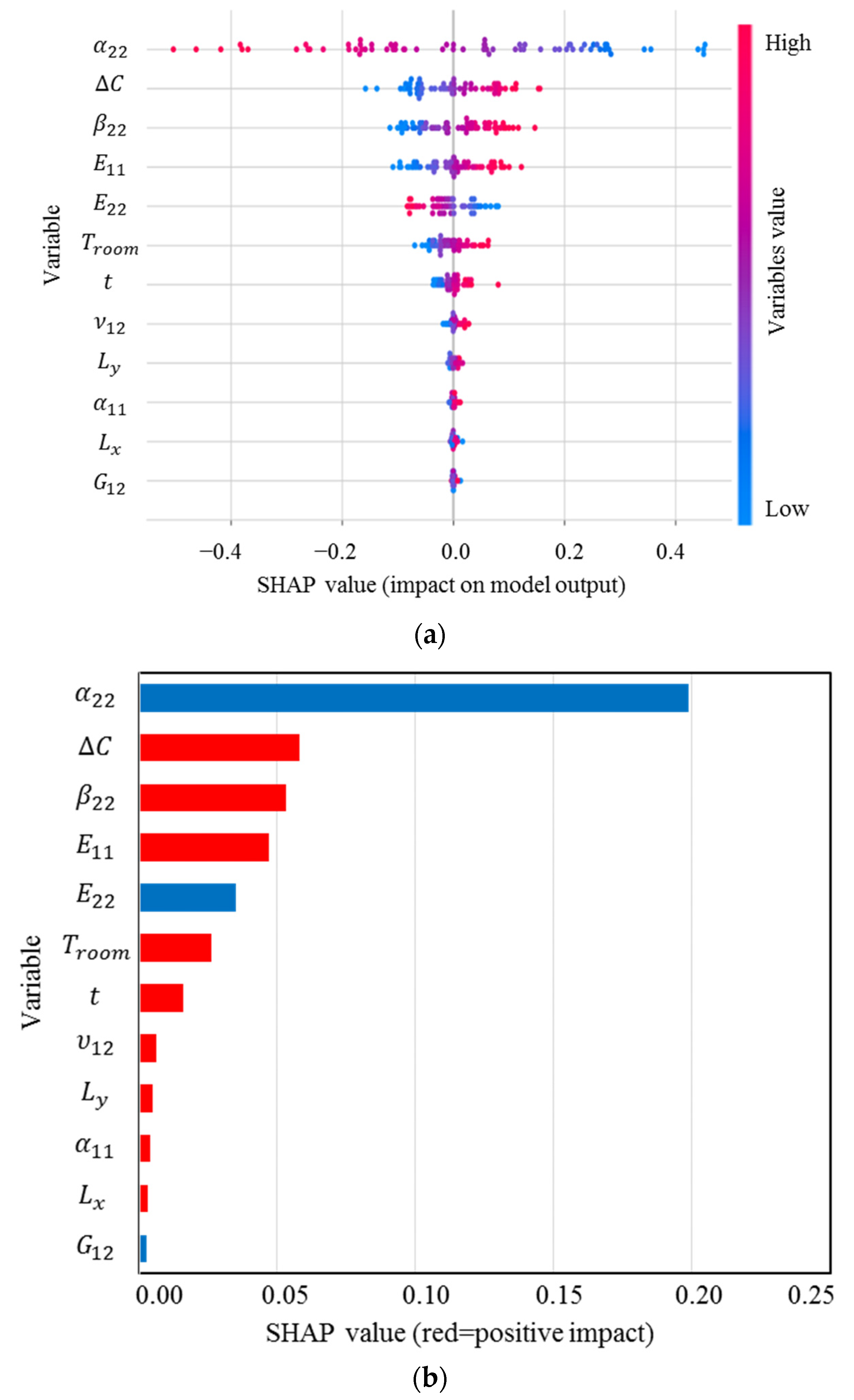

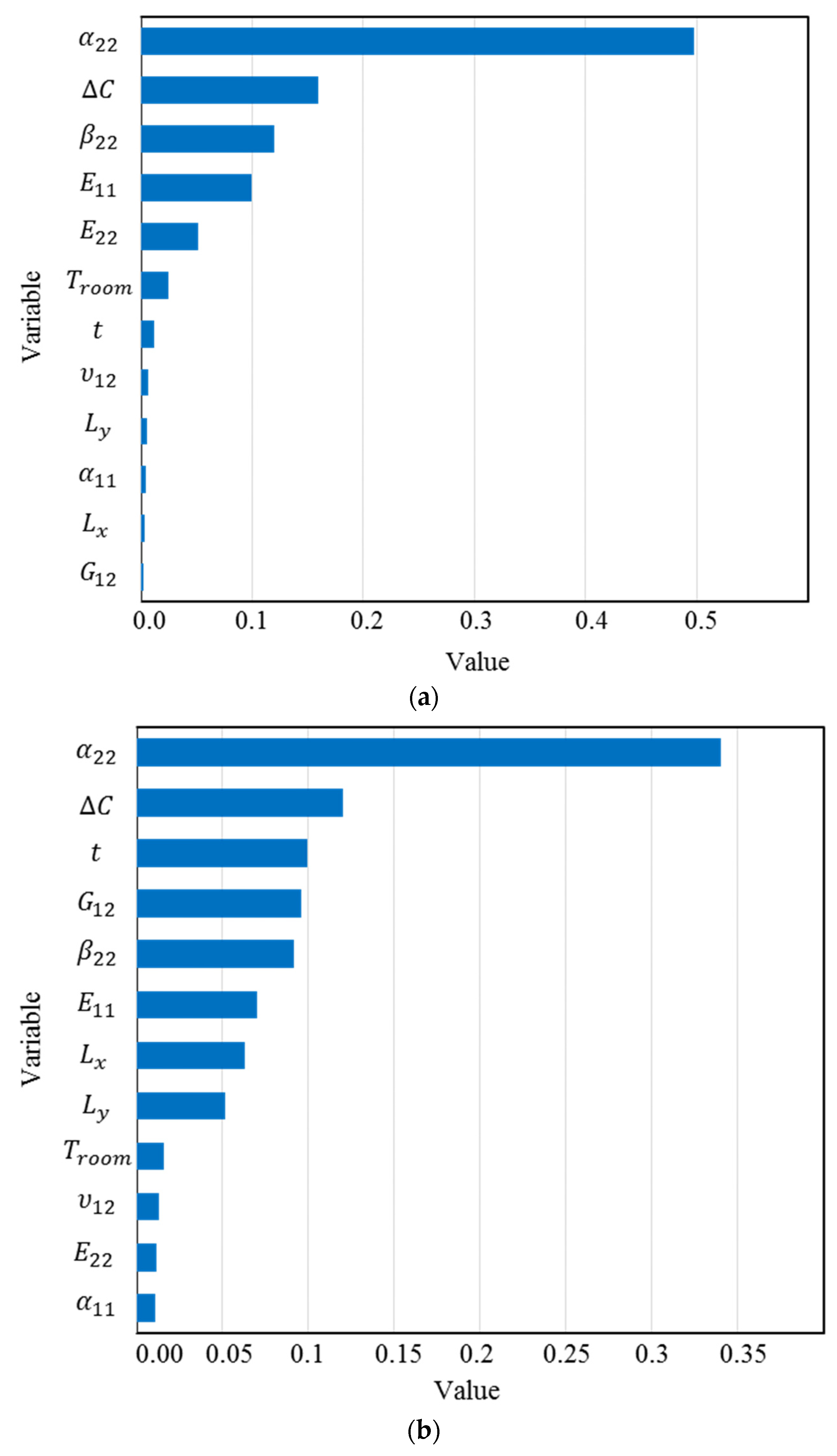
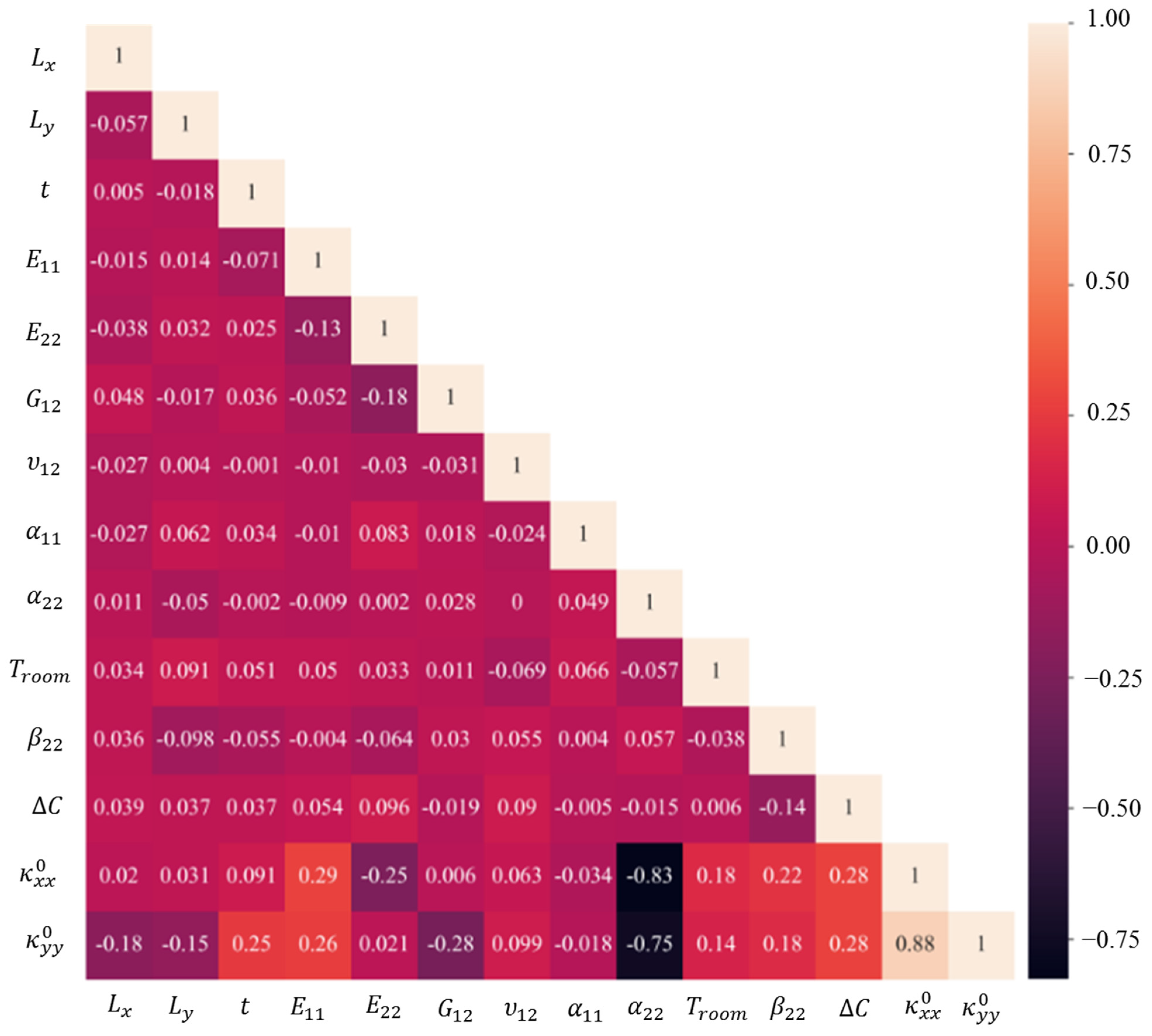




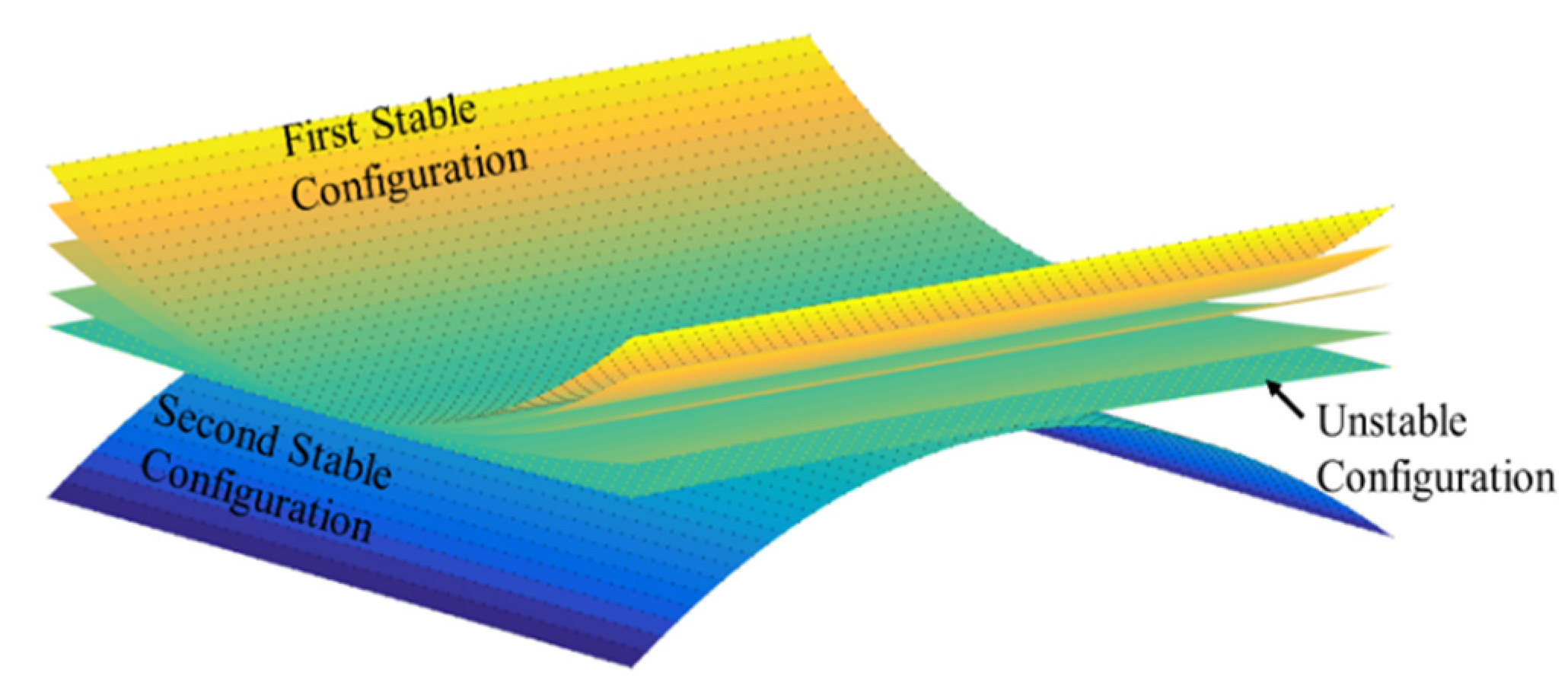
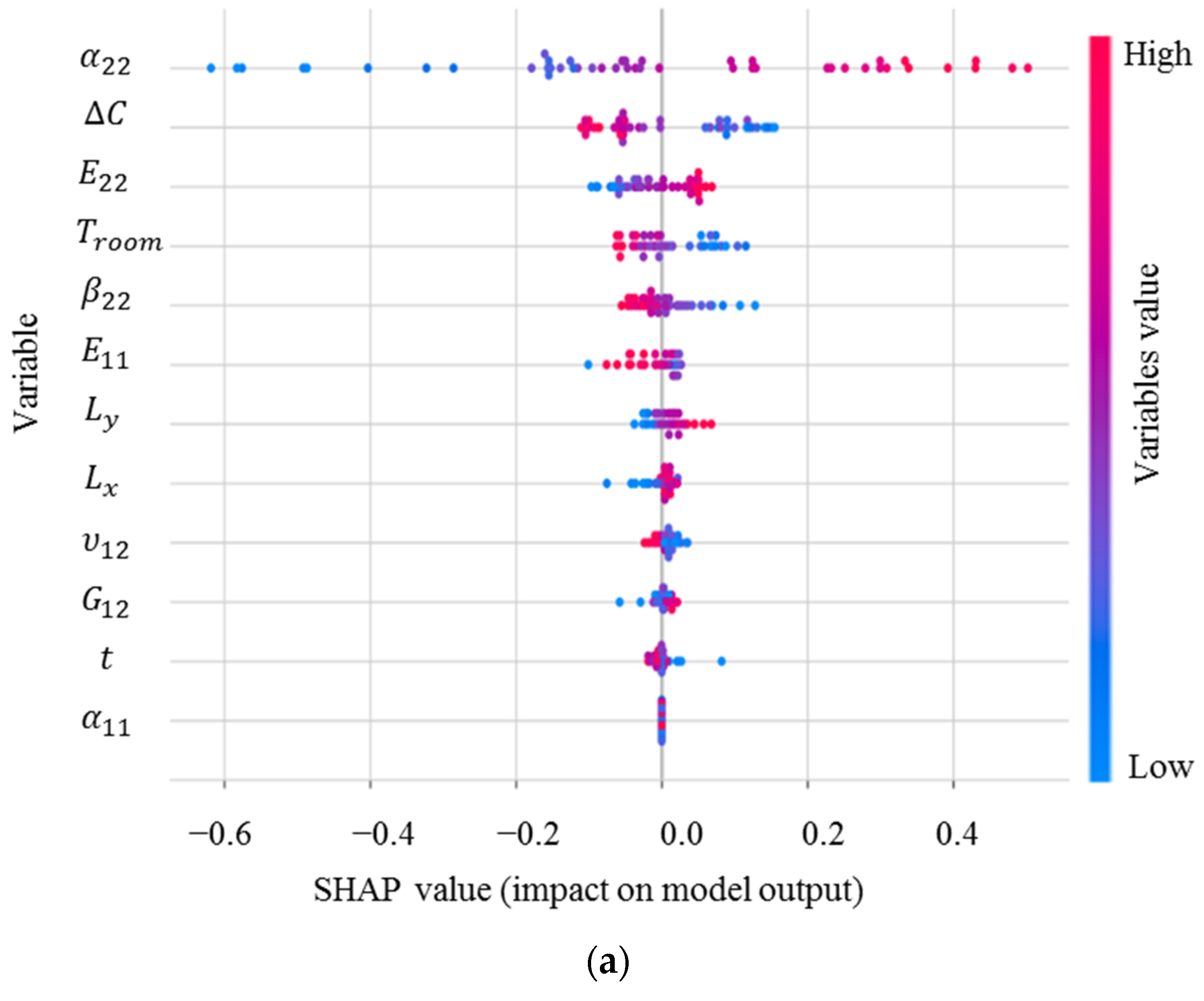

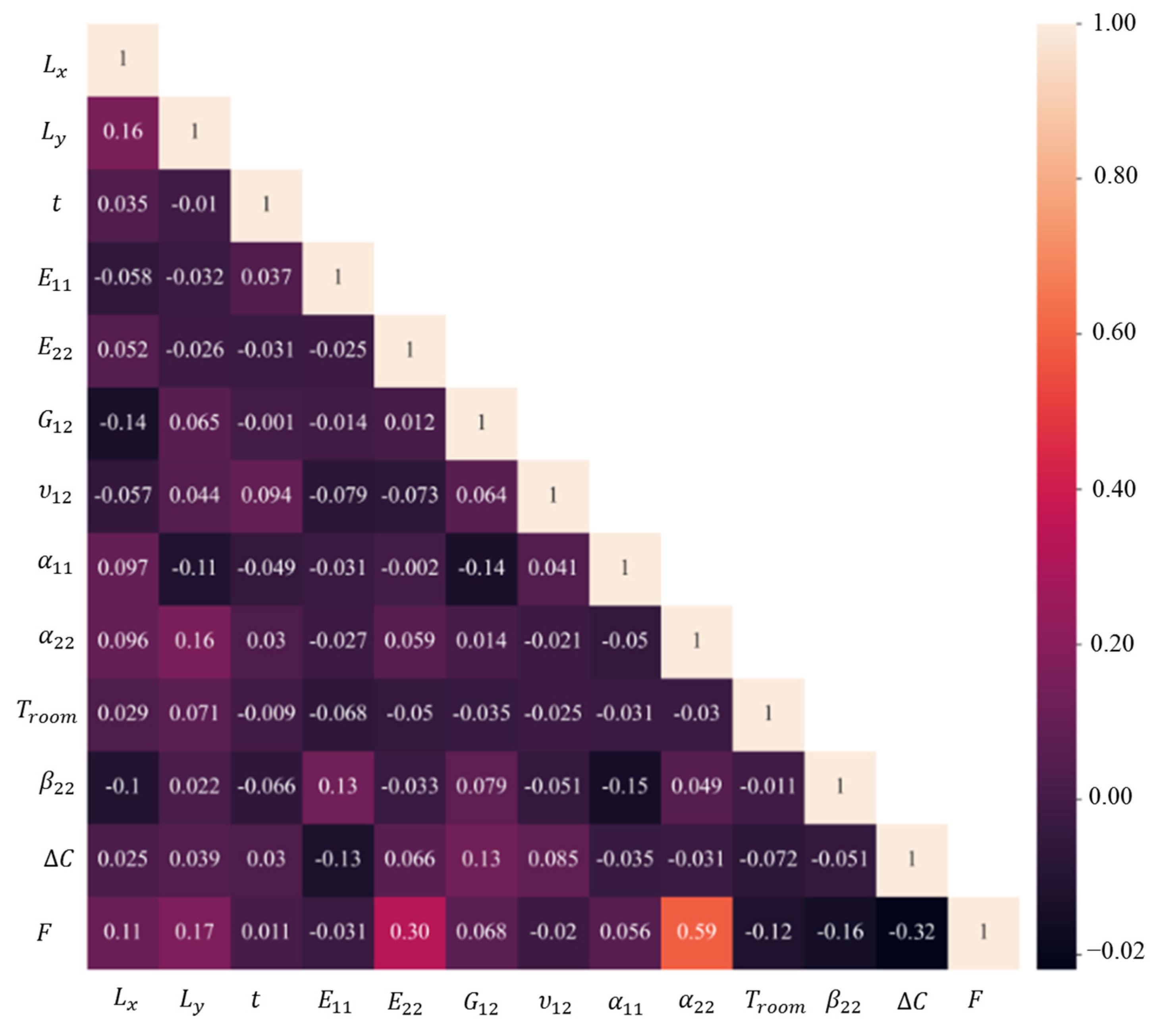
| Parameters | ||
|---|---|---|
| Base score | 0.5 | 0.5 |
| Booster | gbtree | gbtree |
| Colsample by level | 1 | 1 |
| Colsample by node | 1 | 1 |
| Colsample by tree | 0.7 | 0.7 |
| Gamma (γ) | 0 | 0 |
| Number of estimators (N) | 900 | 500 |
| Maximum depth (D) | 3 | 3 |
| Reg alpha (L1) | 0 | 0 |
| Reg lambda (L2) | 1 | 1 |
| Learning rate (α) | 0.05 | 0.07 |
| Minimum child weight | 1 | 1 |
| Property | Mean Value | Coefficient of Variation | |
|---|---|---|---|
| Longitudinal elastic modulus | [GPa] | 146.95 | 0.05 |
| Transverse elastic modulus | 10.702 | 0.05 | |
| Shear module (GPa) | [GPa] | 6.977 | 0.05 |
| Poisson ratio | 0.3 | 0.05 | |
| Temperature variation | 25 | 0.05 | |
| Longitudinal thermal expansion coefficient | 5.028 × 10−7 | 0.05 | |
| Transverse coefficient of thermal expansion | 2.65 × 10−5 | 0.05 | |
| Moisture expansion coefficient | [1/wt%] | 0.005 | 0.5 |
| Moisture variation | 0.3 | 0.05 | |
| Ply thickness | [mm] | 0.365 | 0.01 |
| Side length | [m] | 0.15 | 0.01 |
| Side length | [m] | 0.15 | 0.01 |
| Output | Training | Test | ||
|---|---|---|---|---|
| RMSE | MSE | RMSE | MSE | |
| 2.30 × 10−3 | 5.40 × 10−6 | 5.10 × 10−2 | 2.60 × 10−3 | |
| 3.50 × 10−4 | 1.22 × 10−7 | 1.40 × 10−3 | 2.06 × 10−6 | |
Disclaimer/Publisher’s Note: The statements, opinions and data contained in all publications are solely those of the individual author(s) and contributor(s) and not of MDPI and/or the editor(s). MDPI and/or the editor(s) disclaim responsibility for any injury to people or property resulting from any ideas, methods, instructions or products referred to in the content. |
© 2023 by the authors. Licensee MDPI, Basel, Switzerland. This article is an open access article distributed under the terms and conditions of the Creative Commons Attribution (CC BY) license (https://creativecommons.org/licenses/by/4.0/).
Share and Cite
Saberi, S.; Nasiri, H.; Ghorbani, O.; Friswell, M.I.; Castro, S.G.P. Explainable Artificial Intelligence to Investigate the Contribution of Design Variables to the Static Characteristics of Bistable Composite Laminates. Materials 2023, 16, 5381. https://doi.org/10.3390/ma16155381
Saberi S, Nasiri H, Ghorbani O, Friswell MI, Castro SGP. Explainable Artificial Intelligence to Investigate the Contribution of Design Variables to the Static Characteristics of Bistable Composite Laminates. Materials. 2023; 16(15):5381. https://doi.org/10.3390/ma16155381
Chicago/Turabian StyleSaberi, Saeid, Hamid Nasiri, Omid Ghorbani, Michael I. Friswell, and Saullo G. P. Castro. 2023. "Explainable Artificial Intelligence to Investigate the Contribution of Design Variables to the Static Characteristics of Bistable Composite Laminates" Materials 16, no. 15: 5381. https://doi.org/10.3390/ma16155381






